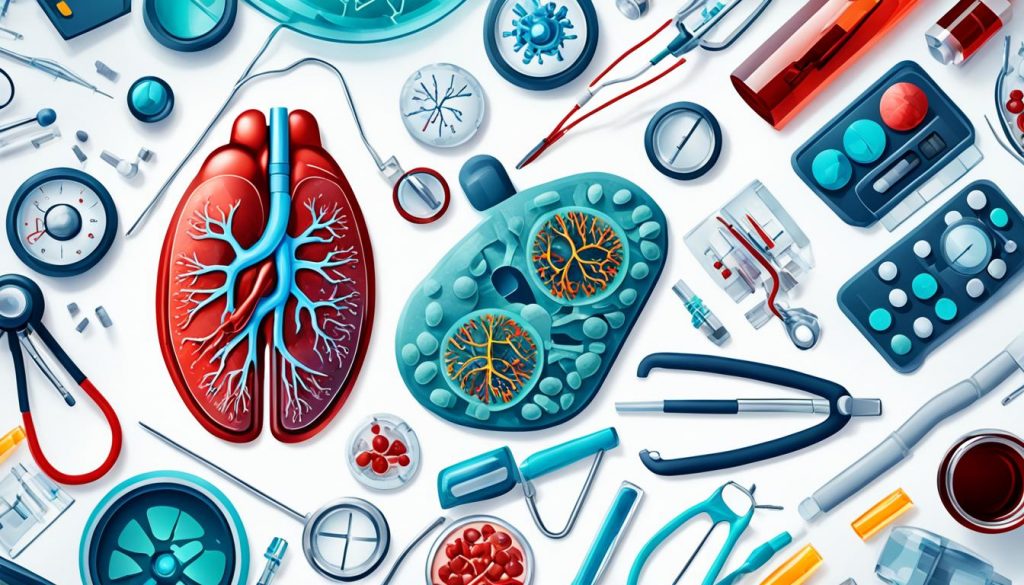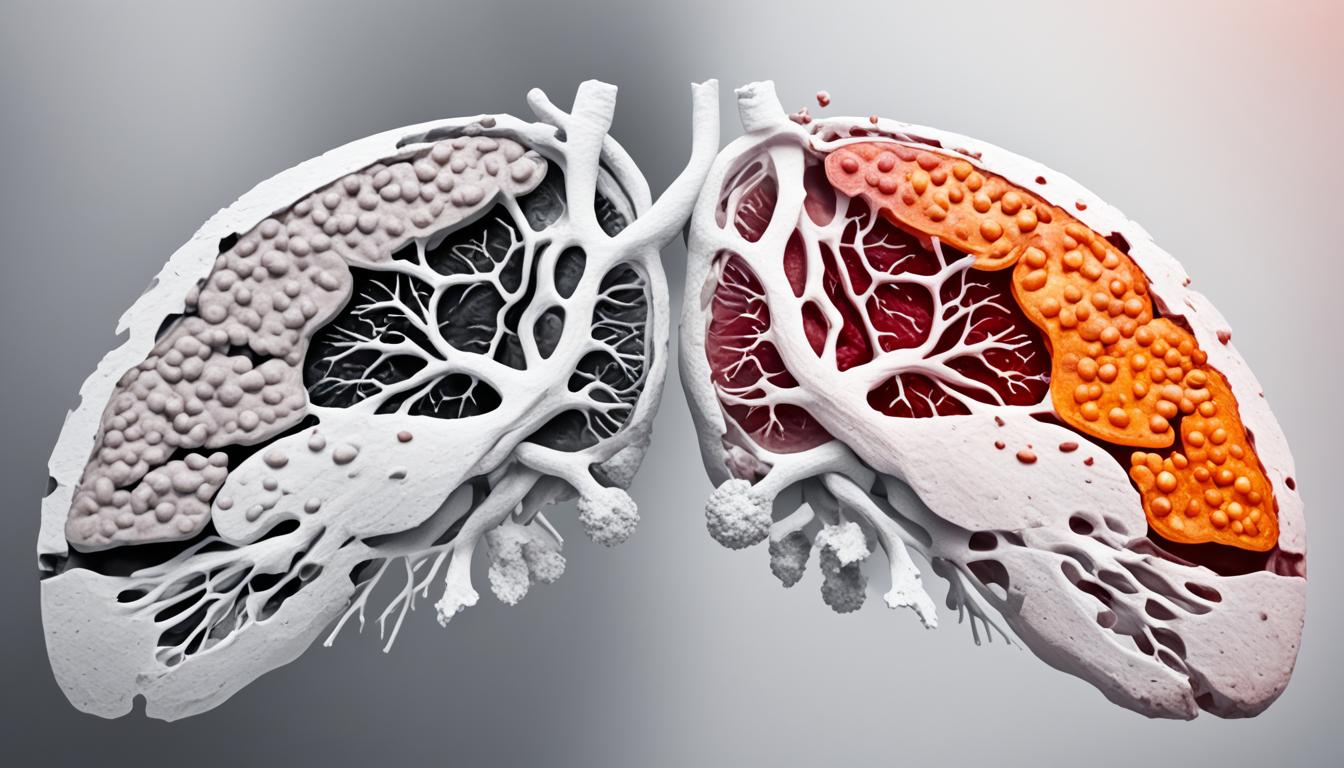Alcohol-associated hepatitis is a liver disease linked to heavy drinking. It brings on inflammation and liver damage. This condition is a type of alcoholic liver disease. It may cause serious issues like liver cirrhosis.
The signs of this disease are jaundice, stomach pain, and a swollen liver. Doctors find it through blood tests, imaging, and a liver biopsy. Managing alcohol-associated hepatitis involves changing your lifestyle, using medicines, and maybe stem cell therapy.
Key Takeaways:
- Alcohol-associated hepatitis is a liver disease caused by heavy alcohol consumption.
- It can lead to serious complications such as liver cirrhosis.
- Symptoms include jaundice, abdominal pain, and liver enlargement.
- Diagnosis involves blood tests, imaging studies, and liver biopsy.
- Treatment options include lifestyle changes, medications, and stem cell therapy.
Prevalence and Impact of Alcohol-associated Hepatitis
Alcohol-associated hepatitis is a common liver disease that affects many people worldwide. It leads to a large number of liver diseases and deaths. These figures show its serious impact on our health systems.
It is the third leading cause of liver transplants in the United States, after chronic hepatitis C and liver cancer. This ranking highlights the disease’s severity and the need for better treatments.
About half of liver cirrhosis-related deaths are due to alcohol. This includes alcohol-associated hepatitis. The high death rate underlines the importance of early treatment and stopping alcohol’s harm to the liver.
Alcohol-associated hepatitis doesn’t just damage the liver directly. It also increases the chances of chronic liver diseases and liver cancer. These risks show why we need to address the issue from various angles to protect public health.
Understanding and addressing alcohol-associated hepatitis is crucial worldwide. By improving prevention, increasing awareness, and making treatments available, we can lower the disease’s effects. This aims to enhance the lives of those with the condition.
Stages of Alcohol-associated Hepatitis
Alcohol-associated hepatitis has several stages. It starts with alcoholic fatty liver disease, where fat builds up in the liver. This phase can often be reversed by stopping alcohol and changing your daily habits.
If alcohol use continues, it may lead to alcoholic hepatitis. This is a serious liver inflammation. It can harm liver cells, cause inflammation, and even lead to liver failure.
Later stages might include fibrosis. This is when scar tissue starts to form in the liver. It happens because of the ongoing damage and inflammation. The liver begins to function differently at this point.
If it is not treated, alcohol-associated hepatitis may reach cirrhosis. In cirrhosis, the liver is badly damaged and doesn’t work well. This is a severe, often permanent condition that sometimes needs a liver transplant to survive.
To better see the stages, take a look at the table below:
| Stage | Description |
|---|---|
| Alcoholic Fatty Liver Disease | The accumulation of fat in the liver due to heavy alcohol consumption |
| Alcoholic Hepatitis | Severe liver inflammation and damage caused by alcohol abuse |
| Fibrosis | The accumulation of scar tissue in the liver, leading to structural changes |
| Cirrhosis | Advanced stage of liver damage where the liver loses its function |
Symptoms and Complications of Alcohol-associated Hepatitis
Knowing the first signs of alcohol-associated hepatitis matters a lot. It helps with quick diagnosis and treatment. With this liver disease, symptoms vary but may include:
- Jaundice: Yellowing of the skin and eyes is a key sign of this condition. It happens because of too much bilirubin in the body.
- Abdominal pain: People often feel pain in the upper right part of their belly. It might be dull, aching, or sharp.
- Liver enlargement: The liver can grow bigger as hepatitis gets worse. A doctor can notice this during a check-up.
- Fatigue: Feeling extremely tired is a common symptom. It can make daily life hard.
- Nausea: Some might always feel like throwing up or lose their appetite because of the disease.
Remember, these symptoms might not only show up in hepatitis. They could be from other illnesses too. It’s vital to see a doctor for a proper checkup.
Not treating this disease can cause major problems. For instance, it can lead to:
- Liver cirrhosis: Long-term liver damage can turn into cirrhosis. This condition slowly replaces healthy liver with scar tissue.
- Liver failure: In bad cases, the liver can stop working. This is life-threatening because the liver can’t clean the blood or make needed proteins anymore.
- Increased risk of liver cancer: Having a damaged liver for a long time can up the chance of getting liver cancer. This includes a type called hepatocellular carcinoma.
Image related to symptoms and complications of alcohol-associated hepatitis:
| Symptoms of Alcohol-associated Hepatitis | Complications of Alcohol-associated Hepatitis |
|---|---|
| Jaundice | Liver cirrhosis |
| Abdominal pain | Liver failure |
| Liver enlargement | Increased risk of liver cancer |
| Fatigue | |
| Nausea |
Diagnosis of Alcohol-associated Hepatitis
Diagnosing alcohol-associated hepatitis is a detailed process. It mixes clinical check-ups, blood tests, and sometimes, a liver biopsy. These steps are key. They confirm the disease, assess liver function, and check for other liver problems.
Blood tests are a standard part of diagnosing. They look at liver health by measuring enzymes like ALT and AST. These enzymes show if there’s liver damage. Blood tests also look for signs of too much drinking, like CDT and GGT.
Imaging studies, such as ultrasound or CT scans, are useful too. They give doctors a look at the liver. This helps spot inflammation, signs of cirrhosis, and other problems.
Sometimes, a liver biopsy is needed to be sure. It involves taking a small piece of liver tissue for closer examination. This shows how much the liver is damaged and if there’s inflammation.
By using clinical evaluation, blood tests, and more, doctors can accurately find and measure alcohol-associated hepatitis.

Diagnostic Methods for Alcohol-associated Hepatitis
| Diagnostic Method | Description |
|---|---|
| Blood tests | Measure liver enzymes, markers of alcohol consumption |
| Imaging studies | Ultrasound, CT scan, or MRI to assess liver condition |
| Liver biopsy | Obtain liver tissue sample for microscopic examination |
Treatment Options for Alcohol-associated Hepatitis
To treat alcohol-associated hepatitis, a mix of lifestyle changes, medicines, and new treatments are used. The main goal is to quit drinking and protect the liver. This is to avoid more damage.
Lifestyle Changes
To beat this disease, changing your life is crucial. This means no more alcohol and living healthier. It’s not easy to stop drinking, so getting help is smart. Eating well and exercising also help your liver a lot.
Medications
Different drugs are given to help with alcohol-associated hepatitis. Corticosteroids like prednisone can lessen liver swelling. They stop more liver damage. Pentoxifylline is another drug that heals liver inflammation and function. The drug you get depends on how bad the sickness is and your health.
Stem Cell Therapy
For some patients, stem cell therapy might be an option. It’s a new way to treat the liver. Stem cells can renew damaged liver parts and help it heal. But remember, this treatment is still being researched. Its results and safety are still being looked into.
Always talk to your doctor about the best treatment for you. Your plan will depend on how sick you are and your other health issues.
Prevention of Alcohol-associated Hepatitis
The top way to dodge alcohol-associated hepatitis is to choose wisely when you drink. It’s key to stick to the advice for drinking moderately. Getting educated and asking for help are important steps. They can lower the chances of getting this liver disease and its related problems.
Educate Yourself and Seek Support
Learning the dangers of too much drinking is vital for prevention. Knowing how alcohol can harm you can push you to change your habits. It’s good to reach out to people you trust if you’re worried about your drinking. Think about getting help from professionals too. They can offer tips to kick bad habits and cut the risk of hepatitis.
Follow National Guidelines for Alcohol Consumption
Many places set rules for drinking to keep it safe. It’s smart to know and stick to these rules. They tell you how much and how often you should drink. Obeying these rules helps you avoid liver problems such as alcohol-associated hepatitis.
Adopt Healthier Coping Mechanisms
Many use drinks to cope with tough feelings, but this can be risky. Finding other ways to relax and feel good is much safer. Try exercise, meditation, or spending time on things you love. Learning these new habits can cut your need for alcohol. This, in turn, lowers your liver disease risk.
The Role of Prevention in Alleviating the Burden
Preventing alcohol-associated hepatitis is crucial for individual and public health. By spreading the word and encouraging safe drinking, we can lower liver disease cases. This saves money on healthcare and focuses help on those in need. It’s all about making life better for those with the disease and lessening the load on healthcare.
| Prevention Strategies | Benefits |
|---|---|
| Limit alcohol consumption or abstain from alcohol altogether | Reduces the risk of developing alcohol-related liver diseases |
| Follow national guidelines for moderate drinking | Promotes responsible alcohol consumption |
| Seek education and support for alcohol dependency | Assists in managing alcohol consumption and reducing dependence |
| Adopt healthier coping mechanisms | Reduces reliance on alcohol for stress relief and emotional well-being |
Impact of Alcohol-associated Hepatitis
Alcohol-associated hepatitis has a big impact on health and healthcare costs. It’s a major share of liver disease burden and a top cause of liver deaths globally.
This illness can lead to severe issues like liver cirrhosis and failure. It also puts people at higher risk for liver cancer. It greatly affects health and quality of life, needing a lot of medical care.
The costs of this illness go beyond just healthcare. They also include things like lost work time and lower life quality. These add to the heavy burden it brings.
Tackling this through early action is key. Teaching people about safe alcohol use and spotting who’s at risk is important. This way, the liver and health of many people can be saved.
The Impact of Alcohol-associated Hepatitis:
- High morbidity rates due to liver inflammation and damage caused by heavy alcohol consumption
- Elevated mortality rates, especially when the condition progresses to liver cirrhosis or liver cancer
- Significant healthcare costs associated with diagnosis, treatment, and long-term management of alcohol-associated hepatitis
- Increased burden on liver disease healthcare resources and services
Fighting alcohol-associated hepatitis needs many steps. These include public health efforts, fast treatment, and reaching out widely. A focus on stopping it, educating, and better healthcare can help a lot.
Conclusion
Alcohol-associated hepatitis is a severe type of alcoholic liver disease. It causes liver inflammation. This can lead to serious health issues.
The key is to spot the early signs. These include yellowing of the skin, stomach pain, and a swollen liver. Getting quick diagnosis and treatment is very important.
Stop drinking alcohol and change your lifestyle to manage this disease. This can help prevent more harm to your liver. Medicines like corticosteroids might be used to help lessen the inflammation.
Stem cell therapy is a new treatment that shows some promise. It could help repair a damaged liver. But, these treatments don’t always work, and it depends on the case and its seriousness.
To stop alcohol-associated hepatitis, we must focus on prevention and education. We need to drink alcohol moderately, and some might need help to stop drinking. By teaching people about this disease, we hope to lower its impact on health and society.

